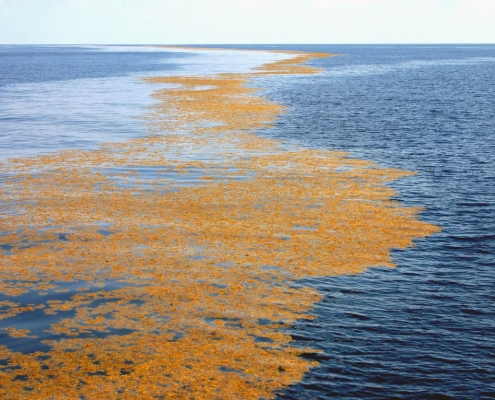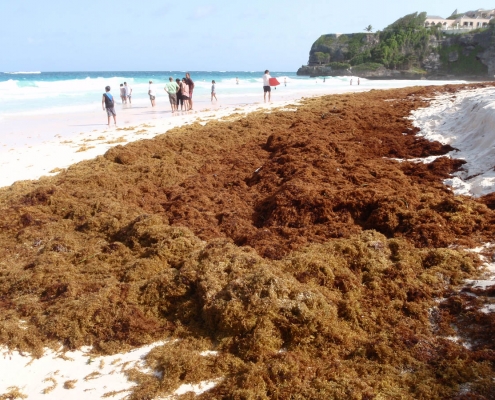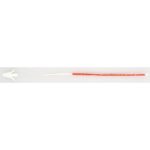
Weed, Weed – too much of a good thing?
Offshore anglers know seeing and fishing a floating Sargassum weed line is a good thing for it they usually are very productive for catching dolphin fish and, if lucky, possibly a marlin. Sargassum is a brown-green microalga, or seaweed, which provides habitat for a significant variety of marine species, particularly juveniles seeking shelter from larger prey species. The structure of the Sargassum plant, includes a stem or stipe attached lateral branches with slender leaves and some have berry-like bladders that fill with air and provide buoyance. The weed plants often never attach to the ocean floor, but rather become interlocked, creating mats and float with the currents.
Beginning in 2011, a Sargassum phenomenon began in the eastern Caribbean Sea when massive amounts of the weed floated in mats on shore, negatively impacting tourism, fisheries, fishing, reefs, sea turtles, mangroves and other coastal resources. (USM, GCRL, 64th GCFI). “It presented immense challenges,” says Hazel Oxenford, a fisheries biologist at The University of the West Indies. Before then, beachgoers had sometimes noticed “little drifty bits on the tideline,” but the 2011 deluge of seaweed was unprecedented, she says, piling up meters thick in places. “We’d never seen it before.” (Science, KJ. Langin, 6/11/18)
In each subsequent year, additional mats arrived. Scientists tracked the origin from reports of additional massive Sargassum events. The weed was coming not from the Sargasso Sea but from the tropical waters off South America and Africa. “It’s catastrophic,” says James Franks, a marine biologist at The University of Southern Mississippi in Ocean Springs, who reported the tracking results in 2016. This year, 2018, Franks, reported “[r]ight now there’s [another] huge mass impacting Puerto Rico, and that’s the last thing they need,” Franks. (Science, KJ. Langin, 6/11/18)

In May, 2018, in a report of the 52nd Antigua and Barbuda Sport Fishing Tournament, included was an acknowledgement of an inexhaustible amount of Sargassum. This may be a condition with which other tournament participants will deal.
The University of South Florida established Sargassum Watch to track the movement of large quantities of Sargassum in the Caribbean Sea and adjacent water. Satellite imagery from 2011 through the present is available on their webpage, along with monthly bulletins during 2018, considered to be a record year for Sargassum blooms. Satellite imagery documents the movement of some of the massive Sargassum mats washing onto shore in south Florida, as reported in the Miami Herald. Other satellite imagery also document that the drifting paths include the Florida Straits and the Gulf of Mexico.








